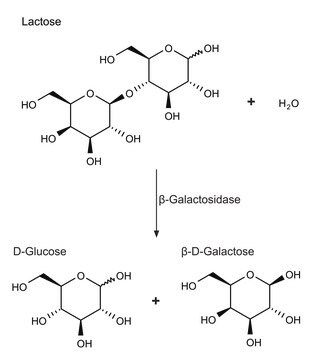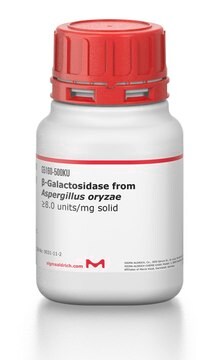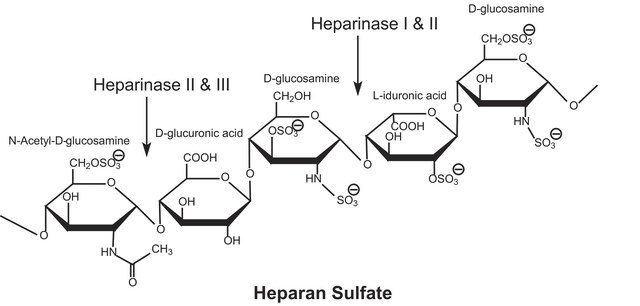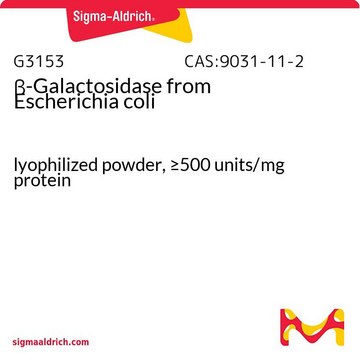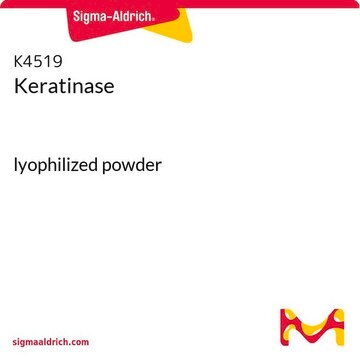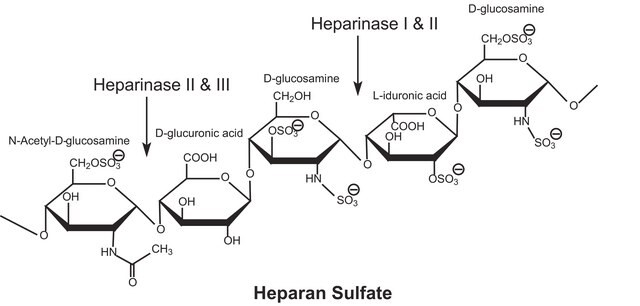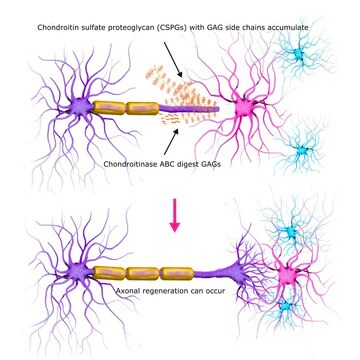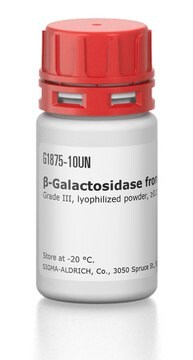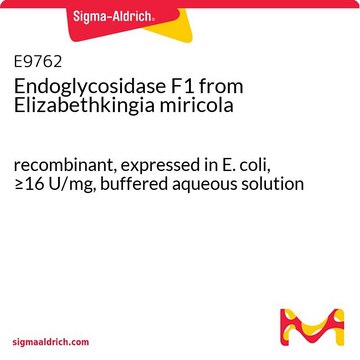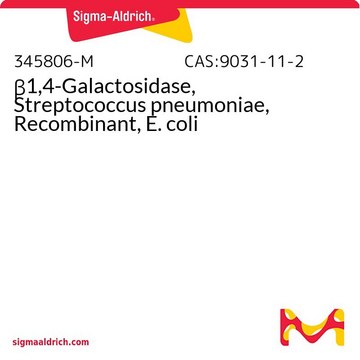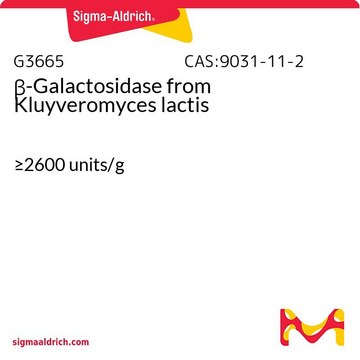Wszystkie zdjęcia(1)
Kluczowe dokumenty
G6920
Endo-β-galactosidase from Bacteroides fragilis
recombinant, expressed in E. coli, ≥140 units/mg protein, buffered aqueous solution
Synonim(y):
β-Galactosidase bacterial, Keratanase
Zaloguj sięWyświetlanie cen organizacyjnych i kontraktowych
About This Item
Polecane produkty
rekombinowane
expressed in E. coli
Poziom jakości
białko sprzężone
(Glucosaminoglycan)
sterylność
aseptically filled
Formularz
buffered aqueous solution
aktywność właściwa
≥140 units/mg protein
masa cząsteczkowa
32 kDa
temp. przechowywania
2-8°C
Powiązane kategorie
Zastosowanie
Endo-β-galactosidase was used in fractional protein isolation. It was used for deglycosylation in glycoproteomics of the endothelial secretome of human endothelial cells.
Działania biochem./fizjol.
Internal β(1-4) galactose linkages in unbranched, repeating poly-Nacetyllactosamine [GlcNAc β(1-3)Gal β (1-4)] structures are the preferred substrate.
Sulfated structures such as keratan sulfate are also cleaved. Branching and/or fucosylation of the substrate may reduce or completely inhibit cleavage. Sulfation of C-6 on galactose will block cleavage. Oligosaccharides of the neolacto-group are cleaved at greatly reduced rates depending on the deviation from the preferred substrate. For example, Gal β(1-3)GlcNAc β(1-3) Gal β(1-4)Glc is cleaved at 5X10-5 the rate of keratan sulfate
β-galactosidase cleaves lactose into its monosaccharide components, glucose and galactose. It also catalyses the transglycosylation of glucose into allolactose, the inducer of β-galactosidase, in a feedback loop.
Sulfated structures such as keratan sulfate are also cleaved. Branching and/or fucosylation of the substrate may reduce or completely inhibit cleavage. Sulfation of C-6 on galactose will block cleavage. Oligosaccharides of the neolacto-group are cleaved at greatly reduced rates depending on the deviation from the preferred substrate. For example, Gal β(1-3)GlcNAc β(1-3) Gal β(1-4)Glc is cleaved at 5X10-5 the rate of keratan sulfate
β-galactosidase cleaves lactose into its monosaccharide components, glucose and galactose. It also catalyses the transglycosylation of glucose into allolactose, the inducer of β-galactosidase, in a feedback loop.
Definicja jednostki
One unit will release 1.0 μmole of reducing sugar from bovine corneal keratan sulfate per minute at 37 °C, pH 5.8.
Postać fizyczna
Aseptically filled solution in 20 mM Tris-HCl, pH 7.5
Ta strona może zawierać tekst przetłumaczony maszynowo.
Kod klasy składowania
10 - Combustible liquids
Klasa zagrożenia wodnego (WGK)
WGK 1
Temperatura zapłonu (°F)
Not applicable
Temperatura zapłonu (°C)
Not applicable
Środki ochrony indywidualnej
Eyeshields, Gloves, multi-purpose combination respirator cartridge (US)
Wybierz jedną z najnowszych wersji:
Masz już ten produkt?
Dokumenty związane z niedawno zakupionymi produktami zostały zamieszczone w Bibliotece dokumentów.
Klienci oglądali również te produkty
Maria Vistnes et al.
PloS one, 9(3), e89621-e89621 (2014-03-07)
We hypothesized that cleavage of the extracellular matrix (ECM) proteoglycans versican and aggrecan by ADAMTS (a disintegrin and metalloprotease with thrombospondin motifs) proteases, which contributes to stress-induced ECM-reorganization in atherogenesis and osteoarthritis, also play a role in heart failure development.
Xiaoke Yin et al.
Molecular & cellular proteomics : MCP, 12(4), 956-978 (2013-01-25)
Previous proteomics studies have partially unraveled the complexity of endothelial protein secretion but have not investigated glycosylation, a key modification of secreted and membrane proteins for cell communication. In this study, human umbilical vein endothelial cells were kept in serum-free
William Mark Erwin et al.
Arthritis research & therapy, 17, 240-240 (2015-09-06)
In the present study, we sought to quantify and contrast the secretome and biomechanical properties of the non-chondrodystrophic (NCD) and chondrodystrophic (CD) canine intervertebral disc (IVD) nucleus pulposus (NP). We used iTRAQ proteomic methods to quantify the secretome of both
Salvatore Santamaria et al.
Scientific reports, 9(1), 10914-10914 (2019-07-31)
ADAMTS (A Disintegrin-like and Metalloproteinase domain with Thrombospondin type 1 Motif)-1, -4 and -5 share the abilities to cleave large aggregating proteoglycans including versican and aggrecan. These activities are highly relevant to cardiovascular disease and osteoarthritis and during development. Here
Xiaoke Yin 殷晓科 et al.
Arteriosclerosis, thrombosis, and vascular biology, 39(9), 1859-1873 (2019-07-19)
Marfan syndrome (MFS) is caused by mutations in FBN1 (fibrillin-1), an extracellular matrix (ECM) component, which is modified post-translationally by glycosylation. This study aimed to characterize the glycoproteome of the aortic ECM from patients with MFS and relate it to
Produkty
Nasz zespół naukowców ma doświadczenie we wszystkich obszarach badań, w tym w naukach przyrodniczych, materiałoznawstwie, syntezie chemicznej, chromatografii, analityce i wielu innych dziedzinach.
Skontaktuj się z zespołem ds. pomocy technicznej